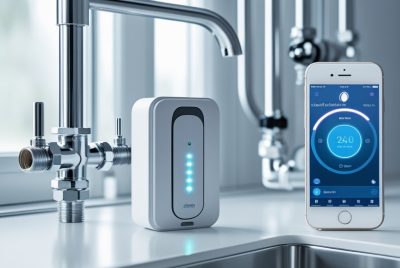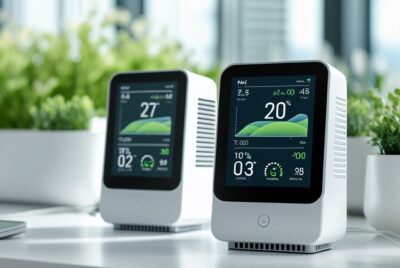Aeotec Smart Home Hub Review: Capabilities and Integration
*We may earn a commission for purchases made using our links. Please see our disclosure to learn more.
Aeotec Smart Home Hub Review: Unveiling the Hub’s Capabilities and Integration
I recently explored the capabilities of the Aeotec Smart Home Hub, which has shown itself to be a versatile and central component of today’s smart home ecosystems. As a wireless device, it serves as the unifying point for controlling a variety of smart home devices such as lights, sensors, and locks. Compatibility with protocols like Z-Wave and Zigbee is crucial, and this hub connects to devices using these standards, ensuring a wide range of smart home products can be integrated seamlessly.
The Aeotec Smart Home Hub also stands out with its support for the Matter standard, a promising development in the smart home industry aiming for improved interoperability. The hub’s design is minimalist and aesthetically pleasing, making it a discreet addition to any living space. With the ability to manage up to 100 smart devices, it’s a robust solution for anyone looking to streamline their home automation setup.
Setting Up the Aeotec Smart Home Hub

To ensure a seamless integration into your smart home ecosystem, I’ll guide you through the setup process for the Aeotec Smart Home Hub, including installation, connecting to your network, and registering devices.
Installation Process of the Aeotec Smart Home Hub
Firstly, I power up the Aeotec Smart Home Hub by connecting it to a power source using the included power adapter, ensuring that the voltage matches the specifications on the adapter. To minimize wireless interference during setup, I keep the hub away from heavy metal objects, such as HVAC equipment and appliances. If my hub has an Ethernet port, I prefer to establish an Ethernet connection with my router, as this often provides a more stable initial setup than Wi-Fi.
Connecting to the Network
With the hub powered, my next step is to connect it to my Wi-Fi network. I can use my phone (whether Android, iOS, or iPadOS) with the SmartThings app installed. After creating a Samsung account or logging in, I select the Aeotec brand and navigate to “WiFi/Hub” category to find my specific hub model. The app then guides me through the process, which may involve scanning a QR code on the device to finalize the connection. Optionally, if I prefer or encounter issues with Wi-Fi, I use the supplied Ethernet cable to connect the hub directly to my Wi-Fi router.
Registering Devices
Once connected to the network, I begin registering devices to the Aeotec Smart Home Hub. The hub is designed to work with a diverse range of smart home gadgets, including Z-Wave, Zigbee, and Wi-Fi devices, providing broad compatibility. In the SmartThings app, I follow the on-screen instructions to add each new device, ensuring they are in pairing mode so the hub can detect and register them accordingly. This process centralizes control of my smart devices, allowing for efficient management through the app.
Understanding Aeotec Smart Home Hub and Compatibility

In integrating smart home technology, it’s essential to understand the protocols and devices that my Aeotec Smart Home Hub supports. Ensuring seamless communication between devices is key to creating a harmonious smart home environment.
Supported Protocols
My Aeotec Smart Home Hub is versatile, supporting Zigbee, Z-Wave Plus, and Wi-Fi. This means it can communicate with a wide range of devices using these popular protocols. The inclusion of Zigbee and Z-Wave Plus ensures that I can integrate devices that require low-energy consumption for longer battery life and reliable performance, even in a mesh network. Wi-Fi connection allows for higher data bandwidth devices such as cameras to be seamlessly integrated.
Interoperability with Devices
I’ve made sure that the hub can work with various connected devices, including lighting, thermostats, security cameras, and even kitchen appliances. Here are some specifics:
- Lighting: Control scenes and manage energy use.
- Thermostats: Adjust home temperature remotely for comfort and efficiency.
- Security cameras: Monitor my home with live feeds and recordings.
- Kitchen appliances: Schedule and automate daily tasks for convenience.
Furthermore, my hub facilitates voice control through integration with Amazon Alexa and Google Assistant, enhancing the ease of use.
Partner Ecosystem
I place a high value on compatibility. My Aeotec Smart Home Hub works well within the SmartThings ecosystem—formerly known as Samsung SmartThings. This includes a range of SmartThings-certified devices from brands like Ring, Nest, and others. By fostering interoperability with partner ecosystems, I ensure that users like me can enjoy a broad selection of smart devices and maximize the potential of my smart home setup.
Smart Home Control Interfaces
In my experience with modern smart home ecosystems, having robust control interfaces is paramount for streamlined interactions. Aeotec’s Smart Home Hub provides diverse options for managing your connected devices.
App Interface
Through the SmartThings app, I can access the dashboard of the Aeotec Smart Home Hub. It allows me to monitor and control devices like smart lights, sensors, and security cameras. The app interface is intuitive, letting me create custom scenes and routines to automate various aspects of my home environment. For example, with a few taps, I can set up a “Good Morning” scene that automatically adjusts lighting and temperature.
Voice Commands and Automation
Voice command functionality with Aeotec’s hub is seamless when integrated with platforms like Amazon Alexa or Google Home. I can use vocal instructions to control connected devices or activate scenes. “Alexa, turn on the living room lights” or “Hey Google, activate movie night scene” are commands I use often to initiate predefined automations I’ve set through the hub.
Remote Access Features
One of the prime benefits of the Aeotec Smart Home Hub is the ability to control my smart devices remotely. Regardless of where I am, as long as I have my phone and the SmartThings app downloaded, I can access my account and manage my home. Whether I want to check the status of my Ring doorbell camera or adjust my audio system volume, the remote access feature keeps me connected and in charge.
Troubleshooting and Maintenance

In handling Aeotec Smart Home Hub, I focus on addressing common issues efficiently, ensuring up-to-date software, and managing device resets or removals correctly, which are crucial for maintaining optimal performance.
Common Issues and Resolutions
When troubleshooting the Aeotec Smart Home Hub, I often encounter a few recurrent difficulties.
Zigbee and Z-Wave Connectivity Issues:
- Cannot connect Zigbee or Z-Wave devices:
- Check the Hub LEDs: A green LED indicates proper network connection, whereas a red LED may signal a problem.
- Rebooting: Disconnect the power cable for a minute and reconnect.
- Z-Wave Exclusion: Place the hub in Z-Wave Exclusion mode to remove phantom devices.
Wi-Fi Connectivity Problems:
- If the hub cannot connect to Wi-Fi, I verify the router’s status or signal strength. Temporary network issues can usually be resolved by restarting the router.
Firmware and Software Updates
Staying current with firmware and SmartThings software updates is key. Here’s my checklist for updates:
- Monitor for Updates: Regularly check the SmartThings app for any firmware updates.
- Performing Updates: Follow in-app instructions to conduct updates ensuring the Hub remains connected and powered during the process.
Device Reset and Removal
Resetting or removing devices can often clear away persistent issues. Here’s how I handle these tasks:
- Factory Reset: Hold the reset button for 20 seconds or until the LED blinks amber. This should only be used as a last resort, as it will remove all connected devices and settings.
- Ports and Connections: Ensure wired/Ethernet connections are secure when troubleshooting. I always check the ports and cables if there’s an issue with the wired connection.
- Cloud Control and Security: After a factory reset, re-establish cloud connections and security measures via the SmartThings app.
Expanding Your Smart Home Hub

As an expert in smart home technology, I always emphasize the importance of a flexible and scalable hub that can grow with your needs. The Aeotec Smart Home Hub offers just that by providing a versatile base for integrating a wide range of devices and automation systems.
Adding Devices and Sensors
Z-Wave and Zigbee: I find Aeotec’s compatibility with Z-Wave and Zigbee protocols to be instrumental in adding devices to the Smart Home Hub. To incorporate new devices, it’s as simple as initiating the pairing mode on both the hub and the device. With support for Z-Wave, Zigbee, and Matter in the roadmap, a vast selection of gadgets including lights, motion sensors, and water leak sensors can be connected.
Wi-Fi Devices: For Wi-Fi devices, I ensure they are on the same network as the Smart Home Hub before proceeding. Once the hub is set up through the SmartThings app, I can easily add Wi-Fi electronics like thermostats and cameras by following the in-app instructions.
List of Compatible Device Types:
- Actuators: To control mechanisms like door locks or motorized shades.
- Security Devices: Including sensors and alarms for comprehensive home safety.
- Smart Lighting: Both color and white spectrum bulbs to personalize ambiance.
I also make sure the devices I add are certified as compatible, commonly referenced as partner devices, to ensure seamless operation.
Integrating with Automation Systems
Voice Control with Google and Alexa: The Aeotec Smart Home Hub integrates seamlessly with Google Assistant and Amazon Alexa, enabling me to add voice control to the connected devices spectrum. I can set routines that allow the hub to interact with these voice assistants for a hands-free experience.
SmartThings Platform: Using the SmartThings app, I can guide my hub to become the heart of a complex automation system. It involves creating ‘scenes’ or ‘automations’ within the app for connected devices to interact based on specific triggers or conditions.
By inputting the serial number found on my Smart Home Hub, I can further personalize my experience through firmware updates and advanced settings. Furthermore, the LED on the hub provides me with direct status feedback, which is essential for troubleshooting.
Remember, when expanding your Smart Home Hub, always ensure your hub’s software is up to date to maintain optimal performance and compatibility.
Frequently Asked Questions
Navigating the intricacies of the Aeotec Smart Home Hub can spark several questions. This section aims to clarify some of the most common inquiries users may have.
1. How do I set up the Aeotec Smart Home Hub?
I begin by checking for any firmware updates on my router. Then, I access the internal access point, usually found on the bottom or back of the router. I follow the instructions provided with the hub or via the Aeotec Help Desk to complete the setup process.
2. Is the Aeotec hub compatible with the Home Assistant platform?
Currently, there isn’t any direct reference regarding the compatibility of the Aeotec Smart Home Hub with the Home Assistant platform.
3. Does the Aeotec Smart Home Hub support Matter protocol integration?
As of my last update, the Aeotec Smart Home Hub does not list support for Matter protocol integration.
4. What is the difference between Aeotec Smart Home Hub v3 and v4?
Information detailing the distinctions between Aeotec Smart Home Hub v3 and v4, including any upgrades or feature changes, would be available through Aeotec’s official communications or support channels.
5. How can I connect my Aeotec Smart Home Hub to my Wi-Fi network?
To connect the Aeotec Smart Home Hub to a Wi-Fi network, I usually follow the guided instructions provided within the Aeotec app or the user manual, ensuring my router is compatible and functioning properly.




